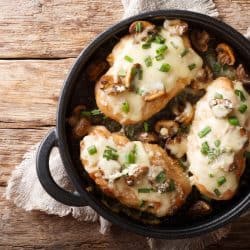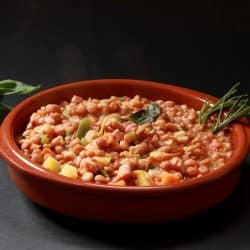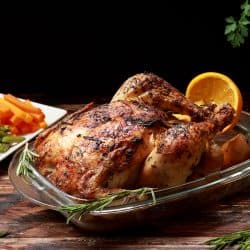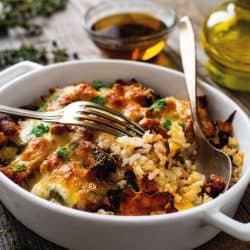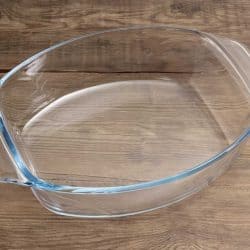That new casserole recipe looks delicious, but does your casserole dish need a lid when you cook it? Some recipes are messier than others, so the question makes sense. We've checked with some of our favorite cooking experts to see what they have to say about whether or not you need that lid.
Many recipes will tell you when you need to cover a casserole dish or not. But a general rule of thumb is that if your recipe is quite soupy or full of liquid, then leave the lid off. This allows the moisture to reduce in the recipe. For less soupy recipes, you may want to leave the lid until the very end when taking it off can finish the dish off with a nice browning of the top.
Let's look at using casserole dish lids a bit more. We'll also discuss the use of foil if it takes longer to cook with foil and when you should cover your recipes in the oven. So please, keep reading.
![Woman wearing apron holding large blue casserole dish, Does A Casserole Dish Need A Lid? [Here's the Rule of Thumb]](https://kitchenseer.com/wp-content/uploads/2020/11/Does-A-Casserole-Dish-Need-A-Lid.jpg)
When To Use A Lid On A Casserole Dish
Your casserole dish came with a lid, but does that mean you need to use it when you're cooking? You don't remember your mom ever putting the lid on the things she cooked, so why did it come with the lid? Some recipes need a lid to keep moisture in, and some recipes don't need the lid so that moisture can reduce as it cooks. Most will tell you in the instructions. But let's look at some common casseroles and see what they have to say about using a lid.
Lasagna
Perhaps one of the most popular types of foods whipped up in a casserole dish is good old Italian lasagna. Layers of pasta, tomato sauce, cheeses, and ground meat meld together to make a classic that's everyone's favorite. Vegetarian? No problem, there are options for you, too.
Click here for this on Amazon.
This Rachael Ray lasagna plan holds a clue as to whether this type of casserole requires a lid or not. In this case, no lid. You will cover it loosely with aluminum foil when it cooks, but that's mainly to keep the top from browning prematurely or juices from spattering on your oven.
Green Bean Casserole
This holiday classic is such a loved family recipe. A simple six ingredients, green beans, cream of mushroom soup, milk, soy sauce, black pepper, and crunchy fried onions, are mixed together and cooked in a circular casserole dish. You don't cover this casserole in the oven because you want that creamy mushroom soup and milk to reduce to a thick, sumptuous sauce for your green beans.
But a lid comes in super handy when you take this casserole to family gatherings. And it will keep your casserole a little bit warm when you take it out of the oven.
A classic white Corningware casserole dish with lid is the perfect choice for a food classic like green bean casserole. It comes with a lid and easy to hold handles for taking your green bean dish to the church supper.
Click here for this on Amazon.
Beef Stew
When you're cooking dishes that require a good slow cook, that's when you need a tight-fitting lid. Stews and other braised recipes need the moisture to stay trapped in the pan. Otherwise, your meat will dry out and become inedible. For these recipes, the tight-fitting lid made specifically for a casserole dish is an excellent choice. Your stew will get that slow-cooked goodness, and you won't have to worry about your meat drying out or liquid splashing onto your stove.
The lidded pots from Le Creuset are the quintessential oven-friendly stew and braising pots. The wide base is perfect for browning the meat on the stovetop before moving it to the oven for slow-cooking and roasting. The cast iron and enamel quality finish come in many colors, and they're so beautiful you'll want to display them in a place of importance in your kitchen.
Click here for this on Amazon.
Salads...in a casserole dish?
Casserole dishes are for more than just the oven. Their handy sizes are good for all sorts of things, from brownies to seven-layer dips to mixed-up salads. Our social times with family, faith families, clubs, and more often involve bringing food and casserole dishes are great for that. They come in decorative styles and are often available with either ceramic or plastic lids that make them great for carrying in a car or other form of transportation. A lid on a casserole dish is a great thing for taking food to gather with friends.
This freezer to oven baking dish comes with an easy snap-on plastic lid that makes storing and traveling easy. You can find these in many different sizes and variations to suit all of your food needs.
Click here for this on Amazon.
Can You Use Foil Instead Of A Casserole Lid?
If you need to cover your food per your recipe, a tight-fitting lid is often your best choice. Sometimes lids that come with casserole dishes are not 100% oven safe, though. If you determined this to be the case, then foil is your next best choice. Make sure it's secured firmly onto your casserole dish while at the same time allowing a bit of space between the foil and your food so that they don't stick to each other.
Does Cooking In Foil Take Longer?
Covering your food with aluminum foil can slow down the cooking times. The foil deflects the heat radiating in your oven. In the case of a casserole, this is not always bad because you want the juices to seep into the other ingredients and cook down to create something that tastes rich and decadent. Why we love casseroles is the way that slow cooking created delicious comfort food flavors.
With casserole recipes, the times stated in the recipe should account for your food being covered. If you're cooking other things in foil, you may want to make adjustments and check your recipe from time to time to make sure it's cooking through.
When Should You Cover Your Food In The Oven?
Cover your food when you need it to cook low and slow. Covering it up allows the moisture to stay trapped and soak up into the food and keep things from drying out. It will also prevent the top of your recipe from browning and burning, and crisping before the entire recipe is ready to eat.
Things like stews, soups, and cassoulets should always be covered when you cook them. Other recipes, like lasagna and macaroni and cheese casseroles, will be covered for part of the cooking time, then uncovered for delicious browning at the end.
We've Covered The Favorites
Now that we've covered the favorites of the casserole world, we hope you understand when and why you might want to say yes to the casserole lid. Whether for cooking, storage, or carrying that dish to an occasion, it's handy to have a lid with your casserole dish.
If you enjoyed this post here at KitchenSeer.com, we invite you to check out a few others you might find interesting below:
What Sizes Do Casserole Dishes Come In?
How To Clean A Burnt Casserole Dish [8 Effective Ways]






